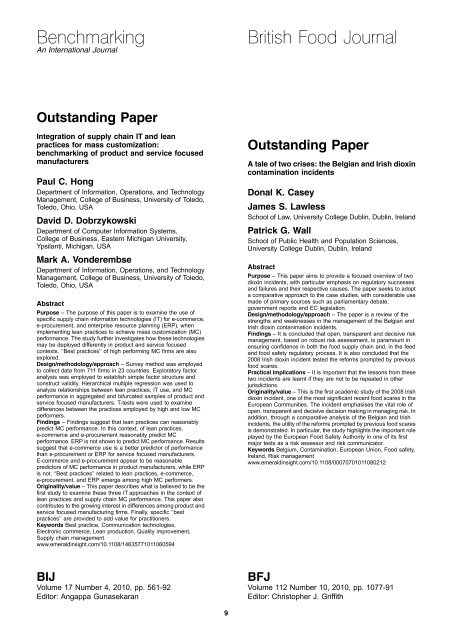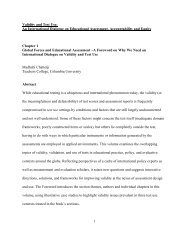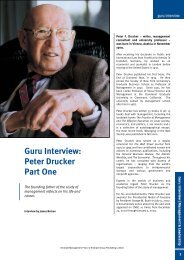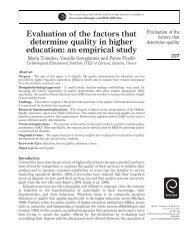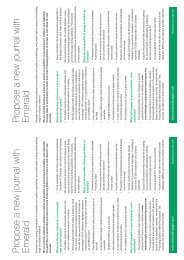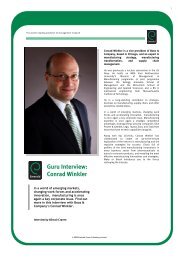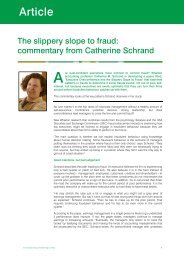Outstanding Paper - Emerald
Outstanding Paper - Emerald
Outstanding Paper - Emerald
You also want an ePaper? Increase the reach of your titles
YUMPU automatically turns print PDFs into web optimized ePapers that Google loves.
Benchmarking<br />
An International Journal<br />
<strong>Outstanding</strong> <strong>Paper</strong><br />
Integration of supply chain IT and lean<br />
practices for mass customization:<br />
benchmarking of product and service focused<br />
manufacturers<br />
Paul C. Hong<br />
Department of Information, Operations, and Technology<br />
Management, College of Business, University of Toledo,<br />
Toledo, Ohio, USA<br />
David D. Dobrzykowski<br />
Department of Computer Information Systems,<br />
College of Business, Eastern Michigan University,<br />
Ypsilanti, Michigan, USA<br />
Mark A. Vonderembse<br />
Department of Information, Operations, and Technology<br />
Management, College of Business, University of Toledo,<br />
Toledo, Ohio, USA<br />
Abstract<br />
Purpose – The purpose of this paper is to examine the use of<br />
specific supply chain information technologies (IT) for e-commerce,<br />
e-procurement, and enterprise resource planning (ERP), when<br />
implementing lean practices to achieve mass customization (MC)<br />
performance. The study further investigates how these technologies<br />
may be deployed differently in product and service focused<br />
contexts. ‘‘Best practices’’ of high performing MC firms are also<br />
explored.<br />
Design/methodology/approach – Survey method was employed<br />
to collect data from 711 firms in 23 countries. Exploratory factor<br />
analysis was employed to establish simple factor structure and<br />
construct validity. Hierarchical multiple regression was used to<br />
analyze relationships between lean practices, IT use, and MC<br />
performance in aggregated and bifurcated samples of product and<br />
service focused manufacturers. T-tests were used to examine<br />
differences between the practices employed by high and low MC<br />
performers.<br />
Findings – Findings suggest that lean practices can reasonably<br />
predict MC performance. In this context, of lean practices,<br />
e-commerce and e-procurement reasonably predict MC<br />
performance. ERP is not shown to predict MC performance. Results<br />
suggest that e-commerce use is a better predictor of performance<br />
than e-procurement or ERP for service focused manufacturers.<br />
E-commerce and e-procurement appear to be reasonable<br />
predictors of MC performance in product manufacturers, while ERP<br />
is not. ‘‘Best practices’’ related to lean practices, e-commerce,<br />
e-procurement, and ERP emerge among high MC performers.<br />
Originality/value – This paper describes what is believed to be the<br />
first study to examine these three IT approaches in the context of<br />
lean practices and supply chain MC performance. This paper also<br />
contributes to the growing interest in differences among product and<br />
service focused manufacturing firms. Finally, specific ‘‘best<br />
practices’’ are provided to add value for practitioners.<br />
Keywords Best practice, Communication technologies,<br />
Electronic commerce, Lean production, Quality improvement,<br />
Supply chain management<br />
www.emeraldinsight.com/10.1108/14635771011060594<br />
BIJ<br />
Volume 17 Number 4, 2010, pp. 561-92<br />
Editor: Angappa Gunasekaran<br />
9<br />
British Food Journal<br />
<strong>Outstanding</strong> <strong>Paper</strong><br />
A tale of two crises: the Belgian and Irish dioxin<br />
contamination incidents<br />
Donal K. Casey<br />
James S. Lawless<br />
School of Law, University College Dublin, Dublin, Ireland<br />
Patrick G. Wall<br />
School of Public Health and Population Sciences,<br />
University College Dublin, Dublin, Ireland<br />
Abstract<br />
Purpose – This paper aims to provide a focused overview of two<br />
dioxin incidents, with particular emphasis on regulatory successes<br />
and failures and their respective causes. The paper seeks to adopt<br />
a comparative approach to the case studies, with considerable use<br />
made of primary sources such as parliamentary debate,<br />
government reports and EC legislation.<br />
Design/methodology/approach – The paper is a review of the<br />
strengths and weaknesses in the management of the Belgian and<br />
Irish dioxin contanimation incidents.<br />
Findings – It is concluded that open, transparent and decisive risk<br />
management, based on robust risk assessment, is paramount in<br />
ensuring confidence in both the food supply chain and, in the feed<br />
and food safety regulatory process. It is also concluded that the<br />
2008 Irish dioxin incident tested the reforms prompted by previous<br />
food scares.<br />
Practical implications – It is important that the lessons from these<br />
two incidents are learnt if they are not to be repeated in other<br />
jurisdictions.<br />
Originality/value – This is the first academic study of the 2008 Irish<br />
dioxin incident, one of the most significant recent food scares in the<br />
European Communities. The incident emphasises the vital role of<br />
open, transparent and decisive decision making in managing risk. In<br />
addition, through a comparative analysis of the Belgian and Irish<br />
incidents, the utility of the reforms prompted by previous food scares<br />
is demonstrated. In particular, the study highlights the important role<br />
played by the European Food Safety Authority in one of its first<br />
major tests as a risk assessor and risk communicator.<br />
Keywords Belgium, Contamination, European Union, Food safety,<br />
Ireland, Risk management<br />
www.emeraldinsight.com/10.1108/00070701011080212<br />
BFJ<br />
Volume 112 Number 10, 2010, pp. 1077-91<br />
Editor: Christopher J. Griffith


